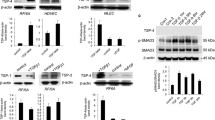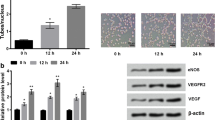Abstract
Tissue inhibitor of metalloproteinases-3 (TIMP3) is a tumor suppressor and a potent inhibitor of angiogenesis. TIMP3 exerts its anti-angiogenic effect via a direct interaction with vascular endothelial growth factor (VEGF) receptor-2 (KDR) and inhibition of proliferation, migration and tube formation of endothelial cells (ECs). TIMP3 has also been shown to induce apoptosis in some cancer cells and vascular smooth muscle cells via MMP inhibition and caspase-dependent mechanisms. In this study, we examined the molecular mechanisms of TIMP3-mediated apoptosis in endothelial cells. We have previously demonstrated that mice developed smaller tumors with decreased vascularity when injected with breast carcinoma cells overexpressing TIMP3, than with control breast carcinoma cells. TIMP3 overexpression resulted in increased apoptosis in human breast carcinoma (MDA-MB435) in vivo but not in vitro. However, TIMP3 could induce apoptosis in ECs in vitro. The apoptotic activity of TIMP3 in ECs appears to be independent of MMP inhibitory activity. Furthermore, the equivalent expression of functional TIMP3 promoted apoptosis and caspase activation in ECs expressing KDR (PAE/KDR), but not in ECs expressing PDGF beta-receptor (PAE/β-R). Surprisingly, the apoptotic activity of TIMP3 appears to be independent of caspases. TIMP3 inhibited matrix-induced focal adhesion kinase (FAK) tyrosine phosphorylation and association with paxillin and disrupted the incorporation of β3 integrin, FAK and paxillin into focal adhesion contacts on the matrix, which were not affected by caspase inhibitors. Thus, TIMP3 may induce apoptosis in ECs by triggering a caspase-independent cell death pathway and targeting a FAK-dependent survival pathway.








Similar content being viewed by others
References
Carmeliet P (2003) Angiogenesis in health and disease. Nat Med 9:653–660
Carmeliet P (2000) Mechanisms of angiogenesis and arteriogenesis. Nat Med 6:389–395
Carmeliet P, Jain RK (2000) Angiogenesis in cancer and other diseases. Nature 407:249–257
Folkman J, D’Amore PA (1996) Blood vessel formation: what is its molecular basis? Cell 87:1153–1155
Hanahan D, Folkman J (1996) Patterns and emerging mechanisms of the angiogenic switch during tumorigenesis. Cell 86:353–364
Chavakis E, Dimmeler S (2002) Regulation of endothelial cell survival and apoptosis during angiogenesis. Arterioscler Thromb Vasc Biol 22:887–893
Gerber HP, McMurtrey A, Kowalski J et al (1998) Vascular endothelial growth factor regulates endothelial cell survival through the phosphatidylinositol 3′-kinase/Akt signal transduction pathway. Requirement for Flk-1/KDR activation. J Biol Chem 273:30336–30343
Bischoff J (1997) Cell adhesion and angiogenesis. J Clin Invest 99:373–376
Chavakis E, Aicher A, Heeschen C et al (2005) Role of beta2-integrins for homing and neovascularization capacity of endothelial progenitor cells. J Exp Med 201:63–72
Apte SS, Olsen B, Murphy G (1995) The gene structure of tissue inhibitor of metalloproteinases (TIMP)-3 and its inhibitory activities define the distinct TIMP gene family. J Biol Chem 270:14313–14318
Visse R, Nagase H (2003) Matrix metalloproteinases and tissue inhibitors of metalloproteinases: structure, function, and biochemistry. Circ Res 92:827–839
Anand-Apte B, Bao L, Smith R et al (1996) A review of tissue inhibitor of metalloproteinases-3 (TIMP-3) and experimentsl analysis of its effect on primary tumor growth. Biochem Cell Biol 74:853–862
Cruz-Munoz W, Kim I, Khokha R (2006) TIMP-3 deficiency in the host, but not in the tumor, enhances tumor growth and angiogenesis. Oncogene 25:650–655
Cruz-Munoz W, Sanchez OH, Di Grappa M, English JL, Hill RP, Khokha R (2006) Enhanced metastatic dissemination to multiple organs by melanoma and lymphoma cells in timp-3-/- mice. Oncogene 25:6489–6496
Lafleur MA, Handsley MM, Edwards DR (2003) Metalloproteinases and their inhibitors in angiogenesis. Expert Rev Mol Med 5:1–39
Majid MA, Smith VA, Easty DL, Baker AH, Newby AC (2002) Adenovirus mediated gene delivery of tissue inhibitor of metalloproteinases-3 induces death in retinal pigment epithelial cells. Br J Ophthalmol 86:97–101
Baker AH, Zaltsman AB, George SJ, Newby AC (1998) Divergent effects of tissue inhibitor of metalloproteinase-1,-2, or -3 overexpression on rat vascular smooth muscle cell invasion, proliferation, and death in vitro. TIMP-3 promotes apoptosis. J Clin Invest 101:1478–1487
Ahonen M, Baker AH, Kahari VM (1998) Adenovirus-mediated gene delivery of tissue inhibitor of metalloproteinases-3 inhibits invasion and induces apoptosis in melanoma cells. Cancer Res 58:2310–2315
Smith M, Kung H, Durum S, Colburn N, Sun Y (1997) TIMP-3 induces cell death by stabilizing TNF-alpha receptors on the surface of human colon carcinoma cells. Cytokine 9:770–780
Baker A, George S, Zaltsman A, Murphy G, Newby A (1999) Inhibition of invasion and induction of apoptotic cell death of cancer cell lines by overexpression of TIMP-3. Br J Cancer 79:1347–1355
Langton K, Barker M, McKie N (1998) Localization of the functional domains of human tissue inhibitor of metalloproteinases-3 and the effects of a Sorsby’s fundus dystrophy mutation. J Biol Chem 273:16778–16781
Bond M, Murphy G, Bennett MR et al (2000) Localization of the death domain of tissue inhibitor of metalloproteinase-3 to the N terminus. Metalloproteinase inhibition is associated with proapoptotic activity. J Biol Chem 275:41358–41363
Ahonen M, Poukkula M, Baker AH et al (2003) Tissue inhibitor of metalloproteinases-3 induces apoptosis in melanoma cells by stabilization of death receptors. Oncogene 22:2121–2134
Bond M, Murphy G, Bennett MR, Newby AC, Baker AH (2002) Tissue inhibitor of metalloproteinase-3 induces a Fas-associated death domain-dependent type II apoptotic pathway. J Biol Chem 277:13787–13795 Epub 12002 Feb 13784
Fata JE, Leco KJ, Voura EB et al (2001) Accelerated apoptosis in the Timp-3-deficient mammary gland. J Clin Invest 108:831–841
Mohammed FF, Smookler DS, Taylor SE et al (2004) Abnormal TNF activity in Timp3-/- mice leads to chronic hepatic inflammation and failure of liver regeneration. Nat Genet 36:969–977
Qi JH, Ebrahem Q, Moore N et al (2003) A novel function for tissue inhibitor of metalloproteinases-3 (TIMP3): inhibition of angiogenesis by blockage of VEGF binding to VEGF receptor-2. Nat Med 9:407–415
Folkman J (2003) Angiogenesis and apoptosis. Semin Cancer Biol 13:159–167
Wen LP, Fahrni JA, Troie S, Guan JL, Orth K, Rosen GD (1997) Cleavage of focal adhesion kinase by caspases during apoptosis. J Biol Chem 272:26056–26061
Tait SW, Green DR (2013) Mitochondrial regulation of cell death. Cold Spring Harb Perspect Biol 5(9):a008706
Wozniak MA, Modzelewska K, Kwong L, Keely PJ (2004) Focal adhesion regulation of cell behavior. Biochim Biophys Acta 1692:103–119
Anand-Apte B, Pepper MS, Voest E et al (1997) Inhibition of angiogenesis by tissue inhibitor of metalloproteinase-3. Invest Ophthal Vis Sci 38:817–823
Qi JH, Ebrahem Q, Yeow K, Edwards DR, Fox PL, Anand-Apte B (2002) Expression of Sorsby’s fundus dystrophy mutations in human retinal pigment epithelial cells reduces matrix metalloproteinase inhibition and may promote angiogenesis. J Biol Chem 30:30
Qi JH, Dai G, Luthert P et al (2009) S156C mutation in tissue inhibitor of metalloproteinases-3 induces increased angiogenesis. J Biol Chem 284:19927–19936
Qi JH, Ebrahem Q, Ali M et al (2013) Tissue inhibitor of metalloproteinases-3 peptides inhibit angiogenesis and choroidal neovascularization in mice. PLoS One 8:e55667
Fox SB, Gatter KC, Leek RD et al (2000) More about: tumor angiogenesis as a prognostic assay for invasive ductal breast carcinoma. J Natl Cancer Inst 92:161–162
Gasparini G, Weidner N, Bevilacqua P et al (1994) Tumor microvessel density, p53 expression, tumor size, and peritumoral lymphatic vessel invasion are relevant prognostic markers in node-negative breast carcinoma. J Clin Oncol 12:454–466
Weidner N, Folkman J, Pozza F et al (1992) Tumor angiogenesis: a new significant and independent prognostic indicator in early-stage breast carcinoma. J Natl Cancer Inst 84:1875–1887
Weidner N, Semple JP, Welch WR, Folkman J (1991) Tumor angiogenesis and metastasis–correlation in invasive breast carcinoma. N Engl J Med 324:1–8
Helleman J, Jansen MP, Ruigrok-Ritstier K et al (2008) Association of an extracellular matrix gene cluster with breast cancer prognosis and endocrine therapy response. Clin Cancer Res 14:5555–5564
Mylona E, Magkou C, Giannopoulou I et al (2006) Expression of tissue inhibitor of matrix metalloproteinases (TIMP)-3 protein in invasive breast carcinoma: relation to tumor phenotype and clinical outcome. Breast Cancer Res 8:R57
Gu P, Xing X, Tanzer M et al (2008) Frequent loss of TIMP-3 expression in progression of esophageal and gastric adenocarcinomas. Neoplasia 10:563–572
Hilska M, Roberts PJ, Collan YU et al (2007) Prognostic significance of matrix metalloproteinases-1, -2, -7 and -13 and tissue inhibitors of metalloproteinases-1, -2, -3 and -4 in colorectal cancer. Int J Cancer 121:714–723
Lai K, Conway RM, Crouch R, Jager MJ, Madigan MC (2008) Expression and distribution of MMPs and TIMPs in human uveal melanoma. Exp Eye Res 86:936–941
Ninomiya I, Kawakami K, Fushida S et al (2008) Quantitative detection of TIMP-3 promoter hypermethylation and its prognostic significance in esophageal squamous cell carcinoma. Oncol Rep 20:1489–1495
Kroemer G, Martin SJ (2005) Caspase-independent cell death. Nat Med 11:725–730
Putcha GV, Le S, Frank S et al (2003) JNK-mediated BIM phosphorylation potentiates BAX-dependent apoptosis. Neuron 38:899–914
Liu W, Ahmad SA, Reinmuth N et al (2000) Endothelial cell survival and apoptosis in the tumor vasculature. Apoptosis 5:323–328
Borges E, Jan Y, Ruoslahti E (2000) Platelet-derived growth factor receptor beta and vascular endothelial growth factor receptor 2 bind to the beta 3 integrin through its extracellular domain. J Biol Chem 275:39867–39873
Schneller M, Vuori K, Ruoslahti E (1997) Alphavbeta3 integrin associates with activated insulin and PDGFbeta receptors and potentiates the biological activity of PDGF. EMBO J 16:5600–5607
Soldi R, Mitola S, Strasly M, Defilippi P, Tarone G, Bussolino F (1999) Role of alphavbeta3 integrin in the activation of vascular endothelial growth factor receptor-2. EMBO J 18:882–892
Woodard AS, Garcia-Cardena G, Leong M, Madri JA, Sessa WC, Languino LR (1998) The synergistic activity of alphavbeta3 integrin and PDGF receptor increases cell migration. J Cell Sci 111(Pt 4):469–478
Acknowledgments
This work was supported in part by US National Institute of Health EY016490 (BA-A), EY020861 (BA-A), EY022768 (JHQ), Foundation Fighting Blindness Center Grant (BA-A), Research to Prevent Blindness (RPB) Challenge Grant and RPB Lew Wasserman award to BA-A. We are grateful to Mariya Ali and Alecia Cutler for providing technical assistance. We wish to extend a sincere apology to colleagues whose work was not cited because of space limitations.
Author information
Authors and Affiliations
Corresponding author
Electronic supplementary material
Below is the link to the electronic supplementary material.
10495_2014_1076_MOESM1_ESM.tif
DEVD and Z-IETD inhibit Caspase 3 and Caspase 8 respectively in PAE cell lysates. Analysis of Caspase 3 and Caspase 8 activity in cell lysates from PAE-KDR/V (V) and PAE-KDR/T3 (W1 and W3) cells treated with DEVD (10 μM), Z-IETD (30 μM) or DMSO as a vehicle control. Supplementary material 1 (TIFF 454 kb)
Rights and permissions
About this article
Cite this article
Qi, J.H., Anand-Apte, B. Tissue inhibitor of metalloproteinase-3 (TIMP3) promotes endothelial apoptosis via a caspase-independent mechanism. Apoptosis 20, 523–534 (2015). https://doi.org/10.1007/s10495-014-1076-y
Published:
Issue Date:
DOI: https://doi.org/10.1007/s10495-014-1076-y




